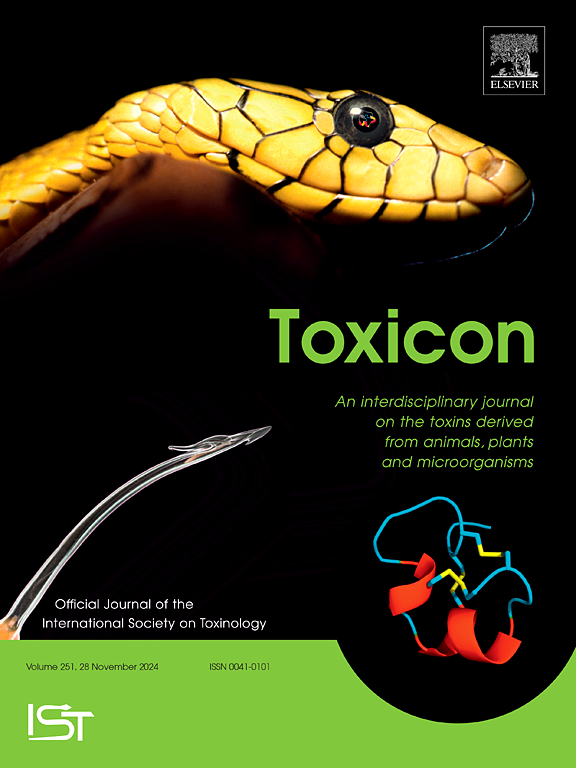The evaluation of earwax as a noninvasive specimen to determine livestock exposure to death camas (Zigadenus paniculatus)
IF 2.6
4区 医学
Q2 PHARMACOLOGY & PHARMACY
引用次数: 0
Abstract
Foothill death camas (Z. paniculatus) grows on the foothill ranges of western North America and is acutely toxic to livestock grazing these ranges. The toxic alkaloids in foothill death camas are zygadenine and a series of zygadenine esters, with zygacine, the 3-acetyl ester of zygadenine, being the most abundant. In this study, earwax was evaluated as a specimen to determine livestock exposure to foothill death camas. Death camas alkaloids were detected in the earwax of sheep administered oral doses of foothill death camas alkaloids. In addition, death camas alkaloids were detected in the earwax of sheep that grazed rangeland with abundant death camas. This study demonstrates the potential of earwax as a noninvasive specimen for chemical analyses to aid in the diagnosis of livestock that may have been exposed to and poisoned by death camas. The results from this study indicate that diagnosticians should analyze for zygacine and zygadenine in the earwax of livestock suspected to have been poisoned by foothill death camas.

将耳垢作为非侵入性标本进行评估,以确定牲畜是否接触过死亡茶花(Zigadenus paniculatus)。
山麓死亡骆驼(Z. paniculatus)生长在北美西部的山麓山脉,对在这些山脉放牧的牲畜有剧毒。山麓死亡骆驼中的有毒生物碱是颧腺宁和一系列颧腺宁酯,其中以颧腺宁的 3-乙酰酯颧腺宁含量最高。在这项研究中,对耳垢作为标本进行了评估,以确定牲畜是否接触了山麓死亡骆驼。在绵羊的耳垢中检测到了死亡骆驼生物碱。此外,在有大量死亡骆驼的牧场上放牧的羊的耳垢中也检测到了死亡骆驼生物碱。这项研究证明了耳垢作为一种非侵入性标本的潜力,可用于化学分析,帮助诊断可能接触过死亡骆驼草并被其毒害的牲畜。这项研究的结果表明,诊断人员应该对怀疑被山麓死亡骆驼毒害的牲畜耳垢中的齐加辛和齐加腺嘌呤进行分析。
本文章由计算机程序翻译,如有差异,请以英文原文为准。
求助全文
约1分钟内获得全文
求助全文
来源期刊

Toxicon
医学-毒理学
CiteScore
4.80
自引率
10.70%
发文量
358
审稿时长
68 days
期刊介绍:
Toxicon has an open access mirror Toxicon: X, sharing the same aims and scope, editorial team, submission system and rigorous peer review. An introductory offer Toxicon: X - full waiver of the Open Access fee.
Toxicon''s "aims and scope" are to publish:
-articles containing the results of original research on problems related to toxins derived from animals, plants and microorganisms
-papers on novel findings related to the chemical, pharmacological, toxicological, and immunological properties of natural toxins
-molecular biological studies of toxins and other genes from poisonous and venomous organisms that advance understanding of the role or function of toxins
-clinical observations on poisoning and envenoming where a new therapeutic principle has been proposed or a decidedly superior clinical result has been obtained.
-material on the use of toxins as tools in studying biological processes and material on subjects related to venom and antivenom problems.
-articles on the translational application of toxins, for example as drugs and insecticides
-epidemiological studies on envenoming or poisoning, so long as they highlight a previously unrecognised medical problem or provide insight into the prevention or medical treatment of envenoming or poisoning. Retrospective surveys of hospital records, especially those lacking species identification, will not be considered for publication. Properly designed prospective community-based surveys are strongly encouraged.
-articles describing well-known activities of venoms, such as antibacterial, anticancer, and analgesic activities of arachnid venoms, without any attempt to define the mechanism of action or purify the active component, will not be considered for publication in Toxicon.
-review articles on problems related to toxinology.
To encourage the exchange of ideas, sections of the journal may be devoted to Short Communications, Letters to the Editor and activities of the affiliated societies.
 求助内容:
求助内容: 应助结果提醒方式:
应助结果提醒方式:


